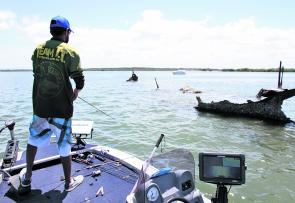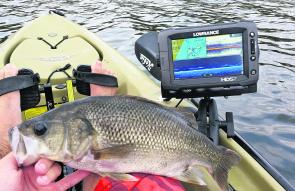So how do you pick the right sounder for your boat? There are heaps of different options available on the market now. Advances in sonar technology the last few years have been incredible and now many of the ‘top end’ features are available in budget priced units.
Of course more options mean it can be tricky to decide on which sounder to get so hopefully this article can help make things a little clearer and get you picking the best sounder for your needs.
Firstly the best way to narrow down the options is to decide on which screen size you need. Everyone has their own fishing styles so it’s important to pick something that will help you the most.
Generally sounders come in sizes ranging from 3” up to 12”. Boat size shouldn’t have a great deal of influence on this decision. What’s important is to make sure that the screen will be big enough to show you what you need. For example, if you like to run split screens, a larger screen will be necessary.
Ideally you will be able to read the screen from your position as you are driving or as you are fishing, without having to squint or get right up to the screen. It’s true what they say, bigger is better – always go the biggest screen you can afford.
There are quite a few different sonar options available, as I have mentioned in previous articles such as traditional 2D sonar, down scan, side scan, chirp etc, and each has their advantages. It pays to do your research on these and work out which will benefit you the most.
Lowrance HDS Units give you the option to chop and change. You can start with a basic Fish Finder/Chartplotter unit and as you save a bit more money you can add features, such as side scan and chirp, whichever is applicable to your style of fishing.
If side scan is your thing, look for a sounder with a wide screen. A wide screen will allow you to show more detail on your image, as opposed to a square shaped screen. When side scanning, you want to be using the whole width of the screen, not necessarily the height. To put it in perspective, a 7” wide rectangle screen is going to give you much better detail and the ability to scan further distances than a 7” square screen would.
The last few years has seen the introduction of touch screen sounders. Available across a number of different brands, at first I was a bit reserved about a touch screen sounder on a boat. My thoughts were that they would be difficult to use in wet weather, with messy fingers, bait etc. This was based on my experiences of trying to use my iPhone with wet fingers in the rain.
When first purchasing my HDS Touch however, I was pleasantly surprised at how responsive the touch screen actually is. One of my first outings was in the rain and I didn’t have any problems at all navigating the screen. They are designed for the harsh marine environment and so if you are worried about it being hard to use, don’t stress!
Touch screen sounders make life a lot easier. Navigating through menus, entering GPS Coordinates and scrolling around the screen is just a touch away and far quicker and easier than having to use the keypad arrows to go back and forth to select the desired option – anyone that has put in a bunch of GPS coordinates this way will know what I mean!
If you like running multiple units on your boat, it’s worth checking if the sounders you purchase will be able to ‘talk’ to each other. Lowrance HDS units are able to share all sonar data when you connect the 2 via an Ethernet cable. This allows you to view your down scan and side scan on more than 1 unit in the boat.
Likewise, it also shares information such as waypoints and trails, which is helpful when you have a separate sounder mounted on the front casting deck. Some sounders will also share GPS Maps; this will save you having to purchase 2 map cards.
Depending on what sort of boat set up you have, there are multiple ways to mount your sounder. Sounders will come standard with a bracket that can be fixed down to any flat surface and is how most anglers mount theirs.
If you are like me and prefer to be able to swing the unit around, there are a plethora of aftermarket brackets and mounts available that you can use. I have my sounder on a RAM bracket that I have fixed down into the gunnel of my boat. I don’t have a wide enough flat spot to mount the standard bracket so the RAM bracket worked well for my set up. I also use one for my front mounted sounder to lift the sounder higher to make it easier to read while standing and fishing.
The RAM bracket mounts also work well on kayaks. Space is generally hard to come by on a kayak so having your sounder mounted on the bracket gives you the option to move it around. A 4, 5 and 7” sized screen tends to be the pick for kayak anglers, any bigger and they can start to get in the way.
So hopefully those few topics will get you thinking about your next purchase and give you a bit of insight into deciding which unit will be best suited for you. Find something that’s within your budget, do some research and most importantly put in the time to learn how to use it.
Reads: 3845
Having a 4-way split screen is a great benefit of a larger screen. Image courtesy of Lee Parkhouse (Simrad NSS12).

A wider screen will allow you to cover a greater area but still keep a crystal clear image.

Obviously space is going to be an issue so check first to see how much room you have and this will help you decide on which screen size sounder you can go with.

A 7” screen is the perfect size for kayaks – big enough without being cumbersome.




